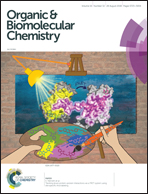Dihydroindeno[1,2-b]pyrroles: new Al3+ selective off–on chemosensors for bio-imaging in living HepG2 cells†
Abstract
In this study, a new molecular organic probe has been designed and synthesized by using recyclable, inexpensive and non-toxic polyethylene glycol (PEG-400) as a promoting reaction medium in water under environmentally benevolent conditions. The probe has been explored as a potential chemosensor to detect Al3+ ions using a HEPES buffer (pH = 7.4) solution. Investigations of the fluorescence behaviour of this sensor in DMSO/H2O (2 : 8, v/v) solution displayed a dramatic switch-on response only in the presence of Al3+, while other metal ions, like Li+, Na+, K+, Ag+, Ca2+, Mg2+, Mn2+, Ba2+, Cu2+, Ni2+, Co2+, Fe2+, Zn2+, Cd2+, Hg2+, Pb2+, Sr2+, Fe3+ or Cr3+, have almost no influence on the fluorescence behaviour. Various common anions, such as ClO4−, Cl−, or NO3− in the form of Al3+ salts [e.g. Al(ClO4)3, AlCl3 or Al(NO3)3], had no influence on the fluorescence behaviour of the sensors. The detection limit for Al3+ is in the order of 10−6 M in DMSO/H2O (2 : 8, v/v) HEPES buffer (pH = 7.4) solution. Notably, this is the first report of a dihydroindeno[1,2-b]pyrrole moiety acting as a sensor for the selective detection of Al3+ ions through an off–on fluorescence response. The potential of the probe was also confirmed by employing it for fluorescence bio-imaging with Al3+ on HepG2 cells.
![Graphical abstract: Dihydroindeno[1,2-b]pyrroles: new Al3+ selective off–on chemosensors for bio-imaging in living HepG2 cells](/en/Image/Get?imageInfo.ImageType=GA&imageInfo.ImageIdentifier.ManuscriptID=C8OB01411F&imageInfo.ImageIdentifier.Year=2018)


 Please wait while we load your content...
Please wait while we load your content...